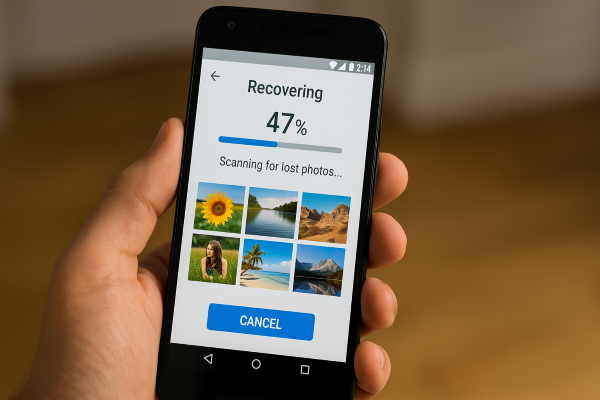Apps
Photo recovery app: recover emotions stored in every click!
Lost important images? With a good photo recovery app, your memories can be easily recovered. Learn how to rescue each memory now!
Advertisement
Relive unique moments with apps to recover photos on your cell phone.

Photo recovery apps have become an indispensable solution for those who have lost valuable images. They represent hope when memories seem to have disappeared forever.
Losing important records can happen at any time. Whether through carelessness, a system error, or a lack of backup, precious photos can disappear unexpectedly.
Seeing memories erased without warning is frustrating. Unique moments, preserved in images, seem lost in time, leaving a feeling of emptiness that's hard to accept.
But there's a way out! Keep reading to discover how apps work to recover lost photos and get your memories back in no time.
How Lost Photo Recovery Apps Work.
Recovering lost photos is possible thanks to amazing technologies. These apps scan your device's memory and find deleted images, restoring precious memories.
This process sparks curiosity because it demonstrates how invisible data can still be accessed. It's almost like magic, but based on applied digital science.
What happens when you delete a photo from your phone.
When you delete a photo, it doesn't disappear immediately. The system simply marks that space as free, waiting for new files to fill it completely.
Until nothing replaces this space, the data remains there, invisible to the average user. It is precisely at this point that recovery is still possible.
The photo recovery app takes advantage of this system loophole by scanning areas designated as empty, but which still contain traces of deleted images.
Therefore, acting quickly increases the chances of success. The less time passes, the less likely it is to be overwritten, preserving memories intact.
Why don't files disappear from memory immediately?
The internal workings of memory are based on storage blocks. When we delete something, the file doesn't physically disappear; it simply loses its direct reference.
This happens because the system prioritizes efficiency. It's faster to mark blocks as available than to manually delete each shard, ensuring continuous performance.
This feature allows old data to remain hidden. Although invisible to us, specialized software can identify and reconstruct files before they are permanently overwritten.
Therefore, the "disappearance" Immediate recovery is merely illusory. In practice, the memories remain there, waiting to be overwritten or retrieved by specialized tools.
How applications locate image fragments in storage.
The applications use algorithms that scan memory sectors. They look for digital signatures in images, identifying patterns that correspond to deleted files.
These signatures help the system differentiate photos from other file types. This allows the application to piece together fragments and reconstruct complete images.
The process can include quick or deep scanning. The latter is more detailed, exploring less accessible areas of the device to find lost traces.
A photo recovery app makes everything accessible by providing previews and allowing the user to choose which memories to restore.
The photo recovery process step by step.
To recover lost photos, understanding each step of the process is essential. From initial analysis to final restoration, each step directly influences the outcome.
These organized phases allow the user to easily follow how images are located, evaluated and returned to the device.
Quick scan for recently deleted files.
Quick scan is the first line of action. It searches for recently deleted images, still preserved in memory, before they are overwritten.
This process uses little energy and time, offering immediate results. It's ideal when the user quickly realizes they've deleted an important photo.
The effectiveness of this feature depends on speed. The sooner the photo recovery app is used, the greater the chances of success.
So, quick scan works like a “immediate rescue”, capable of returning memories with simplicity and speed, without requiring long or complicated processes.
Deep scan and search in hidden sectors of memory.
Deep scanning is the second level of recovery. It explores hidden areas of memory, searching for fragments invisible to ordinary users.
This type of scan takes longer, but it's worth it in depth. It analyzes each sector thoroughly, identifying forgotten images in inaccessible blocks.
Often, files deleted months ago can still be located this way. This demonstrates the power of this more detailed and accurate tool.
With deep scanning, users recover records considered lost by intensively exploring unused space on the device.
Preview and restore: how to choose what to recover.
After scanning, the apps display thumbnails of the found images. This preview helps users select only what they want to restore.
This step saves space and time by avoiding recovering irrelevant files. It's also a confirmation step, providing greater security for the process.
When you choose what to restore, your photos are saved in a secure location. This prevents overwriting and keeps your device working properly.
With a photo recovery app, this final step becomes simple. Users feel complete control when retrieving memories with just a few taps.
The most popular photo recovery apps.
To recover lost photos, millions of people turn to practical and effective apps. Among so many options, some stand out for their popularity and reliability.
These apps have won over users for their combination of efficiency and simplicity. Each offers unique features, helping to restore deleted memories quickly and affordably.
DiskDigger: practicality and results on Android.
DiskDigger is a classic among Android users. It performs efficient scans, finding files that appeared to be permanently deleted.
With a simple interface, it allows anyone to use it without difficulty. It also offers a preview of the images found, making it easier to choose the best ones.
The free version is already well-suited for those seeking basic results. However, the paid version expands features, ensuring greater accuracy and advanced recovery capabilities.
For all these reasons, DiskDigger is considered an essential photo recovery application for anyone looking for speed, convenience, and good results on Android devices.
Dumpster: the smart trash can to avoid losing images.
Dumpster works like a permanent digital trash can. It automatically stores deleted files, allowing you to restore images without time-consuming scans.
This feature prevents the despair of losing important records. The app saves temporary copies, giving the user time to reconsider before permanently deleting them.
With an intuitive design, Dumpster is accessible to any profile. In addition to photos, it can also store videos and other files, expanding its usefulness.
As a preventative system, Dumpster stands out for preventing problems before they even occur. It's like an always-on memory insurance policy.
Tenorshare UltData: Advanced Android and iOS Recovery.
Tenorshare UltData offers solutions for those who need to restore files across multiple platforms. Its compatibility with Android and iOS further expands its reach.
It can recover images, videos, and even app messages. This versatility attracts users looking for a reliable tool for a variety of situations.
The recovery process is guided step by step, making it simple even for beginners. This makes the experience accessible and extremely efficient.
This application has gained notoriety for offering advanced technology and security, restoring important memories, regardless of the operating system.
Conclusion
The loss of important images may seem irreversible, but we have seen that there are simple and efficient alternatives to restore memories that seemed lost.
With different features and depth, each app offers unique advantages. It's up to the user to choose the one that best meets their specific needs.
These tools demonstrate how technology can transform frustrating situations into positive experiences, allowing us to recapture emotions captured in photos.
Did you like it? Want to learn even more practical details? Then check out our article below and see how the DiskDigger app can revolutionize your recovery!
DiskDigger App
Access the article and see how the DiskDigger App can revolutionize your recovery
Trending Topics

Discover how to make WhatsApp stickers with the best apps:
Learn how to make stickers for WhatsApp in a simple and fun way! Use the best apps and unleash your creativity!
Keep Reading
Gaucho live: today's games, how to watch and much more!
Find out how to follow the Campeonato Gaúcho live and stay up to date with all the big games in this competition.
Keep Reading
Discover the photo recovery apps that are saving thousands of memories!
Lost important images? Discover the best apps to recover photos directly from your phone and easily bring back your memories!
Keep ReadingYou may also like

How to watch the Italian Championship live?
This competition is in its final stretch, see all the details so you can watch the Italian Championship live.
Keep Reading
The Passion Unfolded and the Secrets Revealed
Cold Showers Episode 2 brings more mystery and passion between Jayda and Max. Watch now and find out what happens!
Keep Reading
Football players: meet the 10 best of all time
Have you ever wondered who the best football players of all time are? TV em Foco prepared a list of the top 10. Check it out!
Keep Reading

